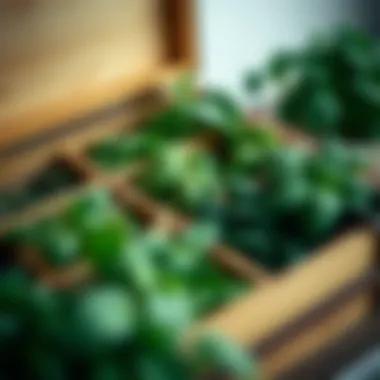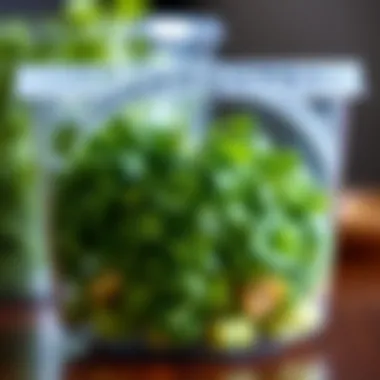Mastering Fresh Herb Storage: A Comprehensive Guide


Intro
Fresh herbs are the unsung heroes of the culinary world. They hold the power to elevate ordinary dishes into extraordinary experiences. However, maintaining their freshness can often feel like trying to catch smoke with your bare hands. That's where the right storage containers come into play.
When you think about keeping herbs vibrant and flavorful, it's not just about throwing them into any old jar. The storage method can make all the difference. Herbs like basil thrive in a moist environment, while others, such as rosemary, do a lot better in dry conditions. Being aware of these nuances is crucial.
Understanding how to choose and use storage containers effectively helps in achieving herb longevity and preserving that all-important flavor. This article aims to take you on a deep dive into the various types of fresh herb storage containers, best practices for keeping herbs fresh, and tips for selecting containers that suit specific herbs. By the end of this guide, you won’t just be storing herbs – you’ll be curating an epicurean experience.
"The right container can be the difference between fresh and wilted."
As we navigate through this guide, expect to uncover practical suggestions and detailed analysis that will arm you with the knowledge to keep your herbs in tip-top shape. Whether you're a seasoned chef or a home cooking aficionado, mastering herb storage is an invaluable skill that will enhance your culinary endeavors.
Understanding the Role of Fresh Herb Storage
Storing fresh herbs might seem like a simple task, but the role of proper herb storage cannot be underestimated. It directly influences not just the longevity of the herbs but also their overall taste and nutritional profile. Imagine opening your fridge one day to find wilted basil when just a few days prior, it was vibrant and aromatic. This unfortunate fate can be avoided with a few smart storage strategies, leading to superior culinary results.
Impact of Proper Storage on Flavor
When it comes to fresh herbs, flavor is everything. Proper storage has a profound impact on how herbs retain their taste and aroma. Think of herbs like cilantro or dill: if they are stored in too warm an environment or even too damp, they can quickly lose their punch. The essential oils that contribute to their unique flavors can dissipate, leaving you with a bland ingredient instead of a star player in your dish.
For example, basil thrives in a slightly humid, cool environment, while rosemary prefers a drier setting. Understanding these needs can take your cooking to the next level, making your dishes sing with fresh flavor instead of singing a sad, wilted tune. Keeping herbs like mint in a glass of water, like a flower arrangement, can prolong their shelf life and flavor vibrancy.
Nutritional Retention in Herbs
Nutritional value is another crucial factor impacted by storage methods. Fresh herbs are often packed with vitamins, antioxidants, and other nutrients. Yet, exposure to light, air, and unsuitable temperatures can rapidly degrade these beneficial properties. For instance, parsley contains vitamin K, and keeping it properly stored not only preserves its bright flavor but also ensures you’re getting all the nutrients it has to offer.
To maximize the nutritional bounty of your herbs, keep them in airtight containers away from direct sunlight. This simple step can significantly hinder nutrient loss. Not only does this ensure your meals are flavorful, but it also means you're feeding your body well. Healthy cooking starts with healthy ingredients.
Environmental Factors Affecting Herb Preservation
Several environmental factors play a role in how well your herbs are preserved. Temperature fluctuations, humidity levels, and air circulation can either breathe life into herbs or cut their lifespan short. For instance, excessive moisture can lead to mold growth, while dry air can cause herbs to go brittle and lose their freshness.
In practical terms, if you’re storing your herbs in the fridge, use breathable materials like paper towels or cloth bags to allow air circulation while retaining moisture. Conversely, if you live in a humid climate, consider using moisture-wicking containers to keep your herbs fresh.
“The secret to keeping fresh herbs lies not only in what you store them in but also the environment they’re kept in.”
By being mindful of these factors, you're on your way to maximizing both flavor and nutrition. Choices made in the kitchen can elevate a meal from standard to exceptional, and fresh herbs are often the simplest yet most effective way to achieve this.
In summary, understanding the role of fresh herb storage goes beyond simply placing them in any container. It’s about tailoring the storage environment to meet the needs of each herb, all while maintaining their essential qualities that contribute to delightful, flavorful dishes.
Types of Fresh Herb Storage Containers
When it comes to storing fresh herbs, the choice of container is crucial. A well-selected storage solution can mean the difference between vibrant, flavorful herbs and sad, wilted leaves that resemble forgotten kitchen scraps. Understanding the importance of different container types is essential for anyone looking to elevate their culinary game.
Plastic vs. Glass Containers
The battle between plastic and glass containers is one many home cooks find themselves in. Both have their merits, but the nuances can affect the life of your herbs significantly.
Plastic containers are light, often airtight, and can come with built-in moisture features. However, not all plastics are created equal; some can leach chemicals into the herbs, particularly if they are exposed to heat or sunlight. Choosing BPA-free options is a must. On the other hand, glass containers, while heavier, promote a safe storage environment due to their non-reactive nature.
When making a decision:
- Weight and Portability: If you frequently move your herbs, opt for plastic.
- Reactivity: For sensitive herbs or long-term storage, glass is usually better.
- Usage Scenarios: If you want quick access, a glass jar that allows visibility is beneficial.
Ultimately, the right choice hinges on your personal storage habits and the herbs you use most frequently.


Specialized Herb Keeper Models
Ah, the world of specialized herb keeper models! These devices are designed specifically to tackle the challenges of fresh herb storage. They often include elements that keep herbs hydrated while minimizing exposure to air, which, as many cooks know, can lead to spoiled produce.
Many models feature water reservoirs at the bottom, akin to flower vases, which can extend the life of leafy herbs like basil and cilantro. Some also come with adjustable vents to control humidity levels, making them quite versatile.
Key features to look for:
- Easy Fill Designs: You should be able to easily refill the water without much fuss.
- Flexibility for Varieties: Look for models that can adapt to herbs of varying sizes and types.
- Visibility: Transparent materials help you check the status of your herbs without opening the container.
Specialized models can be a bit pricier, but they often provide a tailored solution that pays off in the long run by keeping your herbs fresher for longer.
DIY Storage Solutions for Herbs
If you're the crafty type, DIY storage solutions can add a personal touch to your kitchen while effectively preserving your herbs. The beauty of DIY is that you can customize the containers to fit your unique style and storage needs.
Some popular ideas include:
- Mason Jars with Paper Towels: Place a damp paper towel in a mason jar along with the herbs. The towel helps maintain humidity while allowing air circulation.
- Repurposed Glass Bottles: Use old wine bottles filled with water to create a stylish herb vase.
- Egg Cartons for Soft Herbs: An egg carton can cradle delicate herbs like chives or parsley, protecting them from bruising en route to culinary adventures.
The beauty of DIY is its flexibility. You can explore as needed, using materials you already have, while ensuring your herbs are treated with care. Plus, there's nothing quite like the satisfaction of making something yourself!
In summary, the right choice of fresh herb storage containers can greatly impact the quality and longevity of your herbs. Whether you prefer plastic or glass, specialized models, or crafty DIY solutions, a well-thought-out approach will keep your fresh herbs flavorful and the envy of your kitchen.
Choosing the Right Container for Specific Herbs
Selecting the appropriate container for fresh herbs stands as a fundamental step in maintaining their taste, aroma, and nutrient quality. Each type of herb carries unique needs based on their structure, moisture levels, and the conditions they thrive in. By understanding the specific requirements of each herb, one can choose a storage solution that optimally extends their lifespan.
Consider not just the aesthetics of your containers but also their functionality. The right container can preserve flavors and nutritional content, ensuring your culinary creations shine with freshness. Using the wrong storage method can lead herbs to wilt, lose their vibrance, or even spoil prematurely, which is a loss both economically and culinarily.
Storage Needs for Leafy Herbs
Leafy herbs like basil, cilantro, and parsley are delicate and require special treatment to remain fresh. Generally, these herbs thrive best when their stems are in water, somewhat mimicking their natural growing conditions. When storing leafy herbs:
- Use a tall glass or jar: Fill it with water, and place the stems in it, much like a flower arrangement. Cover the leaves loosely with a plastic bag or even a damp paper towel to trap moisture without suffocating them.
- Position the container in the fridge: This method keeps the herbs hydrated while allowing them to get cooler air. The water should be changed every few days to avoid stagnation.
These practices can yield vibrant, flavorful herbs that add dynamism to your dishes, ensuring each bite carries a hint of garden freshness.
Preservation Techniques for Sturdy Herbs
Herbs such as rosemary, thyme, and oregano possess tougher, woody stems and generally require different storage techniques. Unlike their softer counterparts, these sturdy herbs can stand a little neglect yet still maintain their essence. Here are key approaches for their preservation:
- Wrap in a damp cloth: Sturdy herbs can be bundled and wrapped in a slightly damp cloth before being placed inside a container. This will prevent wilting while allowing for airflow.
- Use airtight containers: Sturdy herbs can thrive in a refrigerated environment for longer periods when stored in airtight containers, which limits exposure to moisture and mold. Each herb should be completely dry before storage to avoid unexpected spoilage.
- Keep in a cool, dark place: For longer-term storage, adding herbs to sealed jars and placing them in a pantry can preserve their flavor while remaining easily accessible.
Employing these methods ensures you’ll have hearty herbs ready to add flavor to your meals without losing their robust qualities.
Herbs with High Moisture Content
Herbs with high moisture content, like cilantro and mint, can present a bit of a challenge due to their propensity to rot quickly. These require more attention than their drier counterparts. Here’s how to keep these moisture-rich herbs fresh:
- Store in the fridge without water: Unlike leafy herbs, high-moisture varieties might fare better when wrapped in a damp paper towel and then placed in a perforated plastic bag in the fridge. Avoid submerging the stems in water, as that can lead to quick decay.
- Consider herb keepers: Specialized herb keepers maintaining a controlled amount of humidity can be a great option. These devices create an ideal environment for moisture-loving herbs, ensuring they remain crisp and flavorful.
- Change the paper towel: If the towel becomes overly wet, it’s crucial to replace it to prevent the growth of mold while ensuring a consistent moisture level in the container.
By paying close attention to the storage specifics of high-moisture herbs, their vibrant tastes can transcend your cooking, adding freshness that is often hard to achieve with dried alternatives.
Ultimately, the value of proper herb storage can't be overstated. The right container can be the difference between bland and brilliant in your culinary endeavors.


Maintaining Freshness: Best Practices
Maintaining the freshness of herbs is a crucial aspect of culinary mastery that often gets overlooked. Fresh herbs not only elevate flavors but also add vibrant colors and essential nutrients to dishes. Storing them properly ensures they remain aromatic and viable for as long as possible. This section will delve into three key best practices that can significantly enhance the longevity and quality of your fresh herbs: optimal temperature and humidity levels, regular water changes in storage containers, and the importance of proper handling and cleaning before storage.
Optimal Temperature and Humidity Levels
The environment where herbs are stored plays an integral role in their preservation. Herbs thrive in specific temperature and humidity ranges. Ideally, they like it cool, but not too cold—around 40 to 50 degrees Fahrenheit is considered optimal. This temperature prevents wilting while also staving off the onset of decay.
Humidity is just as important. While most herbs prefer a slightly humid atmosphere to maintain their moisture content, excessive dampness can lead to mold growth, especially for delicate herbs like cilantro or basil. A humidity level of around 50-70% is ideal. For your storage solution, consider the following tips:
- Use breathable containers such as mesh bags or perforated plastic bags to allow airflow.
- If you are using jars, ensure they are not airtight unless the herbs are submerged in water.
- Place your container in a cool part of the kitchen, away from direct sunlight or heat sources.
Regularly Changing Water in Containers
When storing herbs in water, whether in the fridge or on the counter, keeping the water fresh is paramount. Stale water can quickly become a breeding ground for bacteria, which can compromise the quality of your herbs. Regular water changes help maintain a clean environment conducive to lasting freshness. Here are some steps you can follow:
- Change the water every other day or once a day for especially delicate herbs like mint.
- Rinse the stems clean under running water before placing them back in fresh water, ensuring no residual bacteria clings to them.
- Trim the ends of the stems at a slight angle before placing them in the new water. This helps the stems absorb nutrients more efficiently.
Handling and Cleaning Herbs Before Storage
Proper handling and cleaning of herbs is often the unsung hero of successful storage. When herbs are harvested or bought, they need to be treated with care to maximize their lifespan in storage. Here’s how to ensure your herbs are clean and healthy:
- Wash gently under cool running water to remove dirt and pesticides, particularly with leafy varieties like parsley or kale.
- Dry the herbs thoroughly using a salad spinner or by patting them with paper towels. Excess moisture can lead to rotting, so it’s vital to eliminate it.
- Remove any wilted or damaged leaves before storage. This helps to prevent the degradation of good leaves from the decaying ones.
By implementing these best practices, you not only save your herbs from premature spoilage but also enhance the flavors and the nutritional benefits they bring to your culinary creations.
Storing fresh herbs is not merely about putting them in a container; it’s about understanding their needs and creating an environment where they can thrive. The next section will explore innovations in herb storage, reflecting modern approaches to this age-old challenge.
Innovations in Herb Storage
In the culinary world, where the intricacies of flavor and aroma reign supreme, innovations in herb storage have emerged as a game changer. These breakthroughs not only extend the shelf life of fresh herbs but provide chefs and home cooks alike with the tools they need to elevate their dishes to new heights. As herbs fall victim to wilting and loss of flavor, innovative solutions pave the way for keeping these green gems vibrant and palatable.
From cutting-edge technology to sustainable materials, the evolution of herb storage reflects the growing emphasis on food quality and environmental responsibility. Understanding these innovations is crucial for anyone looking to maximize the culinary potential of their herbs.
Smart Storage Solutions for Modern Kitchens
Smart kitchen technology isn't just about fancy appliances; it's about creating an ecosystem that supports better food preservation. In modern kitchens, smart storage solutions are becoming commonplace. For instance, herb storage systems that incorporate humidity control and temperature regulation can make a significant difference. These solutions often utilize sensors to monitor conditions and adjust as needed, which can help keep herbs fresh for an extended period.
Another noteworthy advancement is the integration of app-based features in storage containers. These containers can alert users when the herbs need to be used or when they are on the verge of spoilage. This not only reduces waste but encourages users to incorporate these fresh ingredients into their meals more regularly.
"The right storage can mean the difference between a wilted bunch of herbs and a garden-fresh flavor."
Eco-Friendly Storage Options
With sustainability pacing ahead as a global priority, eco-friendly storage options for herbs have gained traction. Many innovative containers are now made from recycled materials, which help reduce the carbon footprint associated with traditional plastic storage. Furthermore, biodegradable containers are on the rise, offering an alternative to petroleum-based plastics.
One interesting concept is the use of living herb planters, designed to keep your herbs growing while you use them. These planters often have self-watering capabilities, which ensure that herbs are hydrated without over-saturating them. They blend functionality with aesthetics, making it easy to incorporate herbs into any kitchen décor.
When it comes to eco-conscious choices, look for options like bamboo storage solutions or glass containers with silicone seals that ensure freshness while avoiding chemical leaching into food.
Trends in Herb Preservation Technology
The landscape of herb preservation technology is constantly evolving. One notable trend is the use of vacuum-sealing technology which aids in removing air from storage bags or containers, thereby slowing down the spoilage process. Vacuum-sealed bags offer minimal exposure to oxygen, thus maintaining the herb’s potency and freshness significantly longer than traditional storage methods.
Moreover, advancements in molecular gastronomy are inspiring new preservation tactics. Techniques such as flash freezing allow chefs to capture the essence of herbs just before they wilt. These innovations not only extend shelf life but also help preserve the unique flavors that herbs bring to the table.


An increasing number of home cooks and professional chefs are turning to ultrasonic cleaning and preservation methods, which use sound waves to eliminate bacteria without compromising the herb’s natural oils and flavors. This technology is still relatively new, but its potential is considerable and could redefine herb storage practices in the years to come.
Common Mistakes in Herb Storage
Preserving the freshness and flavor of herbs can be a bit of a tightrope walk. One false move, and your cherished greens can go from bright to limp faster than you can say "basil pesto." This section pinpoints some common pitfalls in herb storage that can sabotage your culinary ambitions. Knowing what to avoid is just as crucial as knowing what to do right.
Using the Wrong Container Material
The choice of container can make or break your herbs. Using plastic might seem convenient for its lightweight and adaptable nature, but it can also create a suffocating environment. Plastic can trap moisture and odors, leading to mold and spoilage. Instead, opt for glass or ceramic when you can. These materials are breathable and allow your herbs to stay fresh for a longer time.
When considering the right container, think about the herb type you are storing. For tender herbs like cilantro and parsley, a tall glass jar filled with water to keep the stems hydrated is ideal. On the other hand, woody herbs like rosemary or thyme may fare better in a breathable container that allows some airflow.
One important note: Avoid metal containers entirely for storing herbs, as they can react with moisture and chemicals, altering the flavor and quality.
Ignoring Ethylene Gas Production
Ethylene gas is that sneaky little molecule that can cause your fresh herbs to wilt prematurely. Many fruits, like apples and bananas, emit this gas. If you store your herbs in close proximity to these ethylene-producing culprits, chances of the herbs enduring a quick demise increase substantially.
To combat this, it's wise to keep herbs separate from fruits. If your kitchen setup makes it tricky to avoid this, consider using an ethylene-absorbing product in your fridge. This can help prolong the freshness of your herbs and give your cooking the flavor boost it deserves.
"Keeping fruits and herbs apart is like maintaining harmony in a kitchen—proper separation leads to greater culinary joy!"
Overcrowding Storage Containers
When it comes to herb storage, less can actually be more. Overcrowding your containers can lead to a high humidity environment. This encourages decay and yellowing, cutting short the vibrant life of your herbs. Remember, unlike a big family gathering, herbs need their space to breathe!
One handy rule of thumb is to store herbs in small batches. Stagger their arrangement in the container so there’s airflow between them. For instance, if you've got a batch of dill, don't just throw it all in a jar—lay it out so each sprig has room to thrive.
Consider this: an overcrowded jar is like a crowded elevator; no one likes to be stuck in there, and they won't last long either! Re-evaluating your storage approach can lead to longer-lasting herbs and more flavorful meals.
By steering clear of these common storage mistakes, you’re not just saving your herbs; you’re also elevating your cooking game. Proper herb storage is an art and a science. Master it and watch your flavor profiles soar.
Caring for Fresh Herbs Beyond Storage
Caring for fresh herbs extends far beyond merely placing them in a container. All the effort you put into ensuring they're stored properly can go to waste if you overlook the nuances of their upkeep. Each herb variety comes with its own set of requirements and characteristics, meaning a tailored approach is essential to make the most of these culinary gems. Understanding how to cultivate, appreciate their lifespan, and ultimately wield them effectively in your kitchen not only enhances your dishes but also elevates the entire cooking experience.
Cultivating Herbs at Home
The first step in ensuring a continuous supply of fresh herbs involves cultivating them right at home. It is not just a practical solution, but a gratifying adventure for any kitchen aficionado. Imagine plucking basil or dill straight from your own windowsill or balcony; it breeds a certain satisfaction.
When you start growing herbs, consider the following:
- Choosing the Right Space: A sunny corner in your kitchen or an outdoor pot is ideal. Most herbs thrive in direct sunlight for at least six hours a day.
- Soil Quality: Use well-drained, nutrient-rich potting mix to boost their growth. Herbs love a bit of TLC when it comes to their environment.
- Watering Regimen: Too much water can drown the roots, while too little can wither them away. A balanced approach keeps them happy.
- Harvesting Techniques: Don’t trim from the top. Pinching off the leaves encourages bushier growth and renewable harvests.
Tending to these plants requires patience and a watchful eye, but what you get in return is an unending supply of vibrant flavors.
Understanding Herb Lifespan
Herbs are like fine wines—they have their prime and their decline. Knowing the lifespan of your herbs can make a difference in effective usage and storage practices. Generally, culinary herbs fall into three categories: annuals, perennials, and biennials.
- Annual Herbs: Basil and cilantro are good examples. They grow, bloom, and die within one growing season. Being more vigilant about their peak period ensures you capture their full flavor.
- Perennial Herbs: Examples include rosemary and thyme that can survive many seasons, giving you the chance to harvest throughout the year. What’s vital here is to prune them regularly to prevent woodiness.
- Biennial Herbs: Dill and parsley fall into this category; they generally grow for two years before permanently dying. Just as you would with annuals, they need timely harvesting to relish their full potential before they bolt.
Being alert to these lifespans helps you plan better and maximize usage, minimizing waste and extending the delights they provide.
Using Herbs in Cooking for Maximum Flavor
Finally, how you incorporate herbs into your cooking can elevate meals from everyday to extraordinary. However, simply tossing fresh herbs into a dish is just scratching the surface. Here are a few pointers:
- Timing of Addition: Add hardy herbs like thyme or rosemary earlier in the cooking process to allow their flavors to meld. In contrast, delicate herbs like basil or chives should be added last for a fresh and vibrant taste.
- Herb Preparation: Consider chopping or bruising to release essential oils, heightening their aromatic qualities. A simple toss between fingers can also do wonders.
- Pairing Herbs: Certain herbs love to mingle—think mint with peas or basil with tomatoes. Understanding these relationships boosts your culinary repertoire tremendously.
"The right herbs can elevate even the simplest of dishes, unlocking a world of flavors that tantalize the palate."
By taking care of herbs well, understanding their nature, and strategically employing their aromas in dishes, you can turn an average meal into a gourmet experience. Keep in mind that freshness is the key, and everything from cultivation to cooking can enhance or detract from the intricate flavors these herbs offer.



